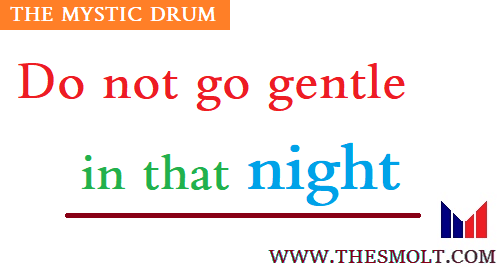Do not go gentle into that Good Night
Do not go gentle into that Good Night is a personal poem by Dylan Thomas, a great poet of the 20th century. Nurtured by Joyce, The Bible, and Freud, Dylan Thomas derived his original strength from that threefold sources.
Ob- secure incantatory, a foreigner to the logic and cohesion of reasoning, he produced alchemy of words and structural combinations range poetry that acts in the manner of a sonorous spell.

The poem is personally written for his father who died on 15th December 1952. Full of contradictions, paradoxes juxtaposition, the poem is at once a defiance of death and an acceptance of it.
Do not go gentle into that good night Analysis
A typical example of such use is in juxtaposing light and night in ‘good night’ which is symbolic of death, suggestive of farewell, and also implies that the night I, e. death is good. It is also underlined with finality and inevitability.
Thomas appeals to his father, not to give in but to struggle against the impend- ing death and obliteration, though at the same he admits the inevitability of death.
Thomas had great respect for his father for his strength of character and independence of judgment, qualities which suffered because of his illness. The father faced night and darkness doubly the darkness of blindness and thee”.
Different people approach death differently and the poem is written in praise of life and acceptance of death. The acceptance is suggested not that of a stoic but one of a warrior struggling to save life into the last.
Dylan Thomas Do not go gentle into that Good Night
The poem ends on an ironic, c, not with Thomas exhorting his father to both bless and curse him. It is natural for the father to bless his son. The father would also curse the son because the Sun will now take his place.

The poem is written in the formal metrical scheme of a villanelle. A villanelle, originally a french form of pastoral lyrics, consists of five three-lined verses (tercets) rhyming aba, and aba, followed by a quatrain rhyming abaa.
The first and the last line of the first tercet are alternatively repeated as refrains at the end of each following tercet.
Read more from Mystic Drum (click)